WESTERN SAMOA
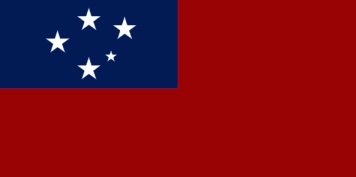
Western Samoa is no more. Its name was changed to simply Samoa in 1997. However, in an effort to differentiate it from its neighbor to the East, American Samoa, we continue to refer to it as Western Samoa as many others do.
Some believe that the Western Samoan island of Savai’i is the legendary Hawaiki from which the first Polynesians spread out across the Pacific. However, the American Samoans dispute this point and believe that their Manua Islands are Hawaiki. Regardless, Western Samoa has been occupied since at least 1,000 B.C.
As discussed on our “American Samoa” page, the Samoas were first sighted by a European, Jacob Roggeveen, in 1722. The Samoans had limited further contact with Europeans until the 1830s when the English missionaries began arriving. According to the Western Samoa Visitors’ Bureau, “by far, the most important agents of change in Samoa were the Western missionaries.” The influence of those missionaries remains obvious today.
During the mid-1800s, consular representation was established in Western Samoa by Great Britain, Germany, and the United States. Problems between these representatives and the Samoan royal families reached a climax in 1889, and Samoan independence was granted by the Final Act of the Berlin Conference on Samoan Affairs.
A new king, Malietoa Laupapa, was crowned. However, he died only nine years later, in 1898, and disputes over succession to the throne followed. These disputes led to a series of conventions whereby Germany annexed Western Samoa (and the U.S. annexed American Samoa) in 1900.
Germany ruled Western Samoa until the onset of World War I when New Zealand’s armed forces occupied the islands. New Zealand was granted a League of Nations mandate over the territory in 1919; however, their rule was not popular among the Samoans. Samoans worked toward their independence which was again granted in 1962.
Samoa is between longitudes 171º and 172º West and latitudes 13º and 14º South. It is comprised of eight small islands and two relatively large islands – Upolu and Savai’i – with the two larger islands comprising 96% of the total land area. The islands are volcanic and dominated by rugged mountain ranges reaching 6,094 feet on Savai’i and 3,608 feet on Upolu. The islands have fringing coral reefs and some lagoons.
Although Savai’i is the largest island, Upolu is the most developed. The capital of Western Samoa, Apia, is on Upolu as is Faleolo International Airport. Apia has a population of over 35,000, and it is the government base, business commercial center, and main port for the nation.
Western Samoa’s population is approximately 175,000. Western Samoans are the most populous full-blooded Polynesian race in the world. Samoan is the national language, but English is the official language of business. Most Samoans are competent in English.
Western Samoa is a traditional society with a distinctive Polynesian cultural heritage. There are at least 362 villages in Western Samoa. Villages are made up of land owned by the aiga (extended family units), and each aiga is headed by a matai (chief). Matai may be male or female. Traditional authority is vested in the matai of the village, and there are an estimated 18,000 matai in Western Samoa. The central structures in each village are the church and the Fale Fono – a structure where the matais meet to discuss village matters.
The Western Samoan economy is mainly agricultural. They grow coconuts and bananas; however, their production of both is declining. A substantial portion of income is from Samoan family members living abroad and sending money ‘home’. They have a large foreign debt and high rate of unemployment.
The harbor in Apia, the only official entry/exit port in Western Samoa, is well-marked and welcoming. Holding is good in depths varying from 15 to 50 feet. (However, a boat had dragged anchor the night before we arrived and damaged another boat that it hit.) The officials are pleasant and efficient, and checking in is relatively quick.
The harbor is in the town of Apia, and that makes trips to town easy. There is a fishing club in the northeast corner of the harbor that makes its dock available to cruising boats for landing dinghys, so getting ashore is easy. (The Apia Yacht Club is way out of town and well away from the harbor.)
Onshore we saw our first traffic stop lights since Kona, Hawaii. That was four months prior. We also found a variety of markets for provisioning. There is a fish market Monday through Friday mornings. Across the street from the fish market is a flea market which is open Monday through Saturday. The flea market is mainly Samoan crafts. But the open-air produce market is the one that should not be missed.
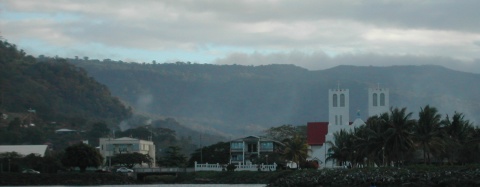
Apia waterfront
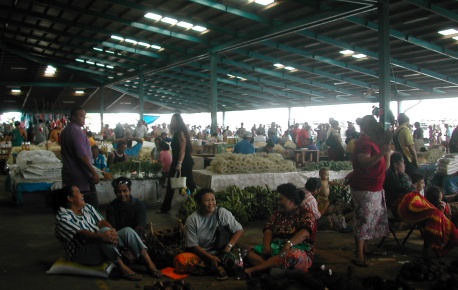
Marketplace
The open-air market is inland a few blocks. There one can find whatever fresh fruits and vegetables are locally grown and a slice of local life. Most sellers and shoppers in the marketplace are women, and many men spend their time in the kava corner. The corner is a small area lined with benches where men can sit around and drink kava. Sorry, no women allowed. There is also an area of food stalls that do a big business, but we refrained. (We try not to eat things we cannot identify.) The marketplace is a great place to shop as well as a cultural experience. We bought soursop, papaya, bananas, and bok choy – all very good. We bought a pomelo that wasn’t very good, but that is probably because we don’t know how to select them.
There are also numerous more pedestrian markets around town. Most of them are typical markets where you roll your cart around and pick up what you want. However, some of them have a behind-the-counter display wall of their products from which you choose what you want. You wait your turn to meet with a clerk sitting at a computer, and the clerk enters your request in to the computer and takes your money. Warehouse workers pull your order and bring it to you. At first glance, we label-readers balked at not being able to read labels and compare ingredients in similar products; however, there are not “similar products” to compare. If you want canned corn, you buy the one and only brand of corn they have. It would take some getting used to, but it seems an efficient system.
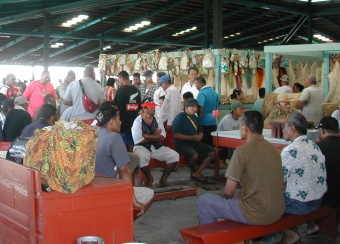
Kava corner
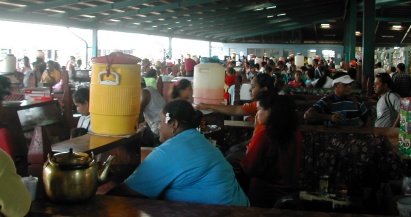
Food stalls outside marketplace
The cost of goods, food and non-food, ranged from inexpensive to very expensive. (The US dollar is currently equivalent to 2.6 Western Samoa Tala.) Fresh baked bread cost $1.20 WST (46 cents USD). However, a small spray can of scotchguard cost $38 WST ($14.62 USD), and a small bottle of soft-scrub cost $12 WST ($4.62). So one has to shop carefully.
We had hoped to find more products than we actually found in Apia. We were on a mission to find powdered skim milk, and we never did. We also needed to buy meclizine, and there was none on the island. It appeared that most of the markets carried the same selection of goods.
Eating out was the same mixed bag as shopping – some good/inexpensive and some lousy/expensive. Our best find was excellent fish and chips for $3 WST ($1.15 USD) within a 3 minute walk of the dinghy dock.
Getting around the rest of Apia was convenient by walking. They have a public bus system, but we did not ride on it. The busses were colorful and personalized somewhat like in American Samoa, but these busses were subdued in comparison.
We also did not rent a car nor visit Savai’i. What we could see of the islands was pretty, but we just weren’t inspired to spend our time touring around. We wanted to move on to a less busy anchorage. (There were 27 boats in the anchorage during our first weekend there!)
We did make it out to watch some local dancing one night. The women dance a form of hula that is quite different from Hawaiian hula and completely different from the high energy hula in French Polynesia. In fact, they don’t use their feet much at all, and they are often sitting on the ground. They use constant hand gestures and subtle facial expressions. It is quite nice to watch. The men, on the other hand, are extremely physical and aggressive. There is nothing subtle about the way they dance. We have been told that this male dancing is tame in comparison to the New Zealand Maoris, but this was energetic and aggressive enough for one evening.
Another energetic male activity here was rowing canoes. The canoes are huge – we counted 44 men rowing plus one steering and one drumming. We actually saw a woman steering one canoe, but we never saw any rowing. And they do have someone drumming on board. Forty two of the men sit two abreast, and they use both hands/arms on one oar. We were surprised that they use large oars rather than paddles. They move fast, and we were told that they participate in open ocean competitions.
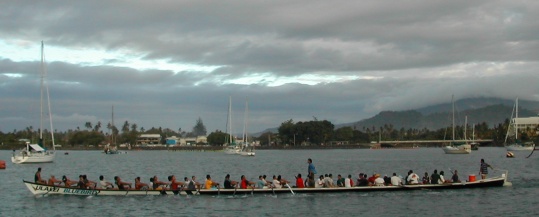
A very big canoe
Our favorite thing we did here was taking our dinghy up a small river that runs in to the harbor. From that perspective, we saw a revealing slice of local life. There were kids playing in the water, fishing boats tied up, people seemingly just relaxing, and an interesting variety of dwellings. Although we don’t enjoy “tours”, we especially enjoy getting out and seeing as much “local” culture as possible.
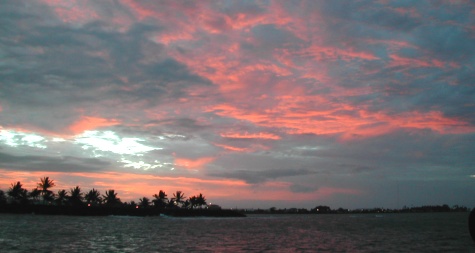
Sunset on Cape Horn
Another milestone was achieved in Apia. We rounded Cape Horn! In our dinghy, no less! Yes, there really is a small spit of land between the yacht anchorage and fishing boat harbor which is called Cape Horn. What an accomplishment!
But we were again ready to move on. After spending time in the busy ports of American Samoa and Western Samoa, we wanted a little isolation and quiet. So we left Western Samoa before dawn on August 30 heading for Niuatoputapu, Tonga.
Read about our sail from Western Samoa to Tonga or jump ahead to Tonga.